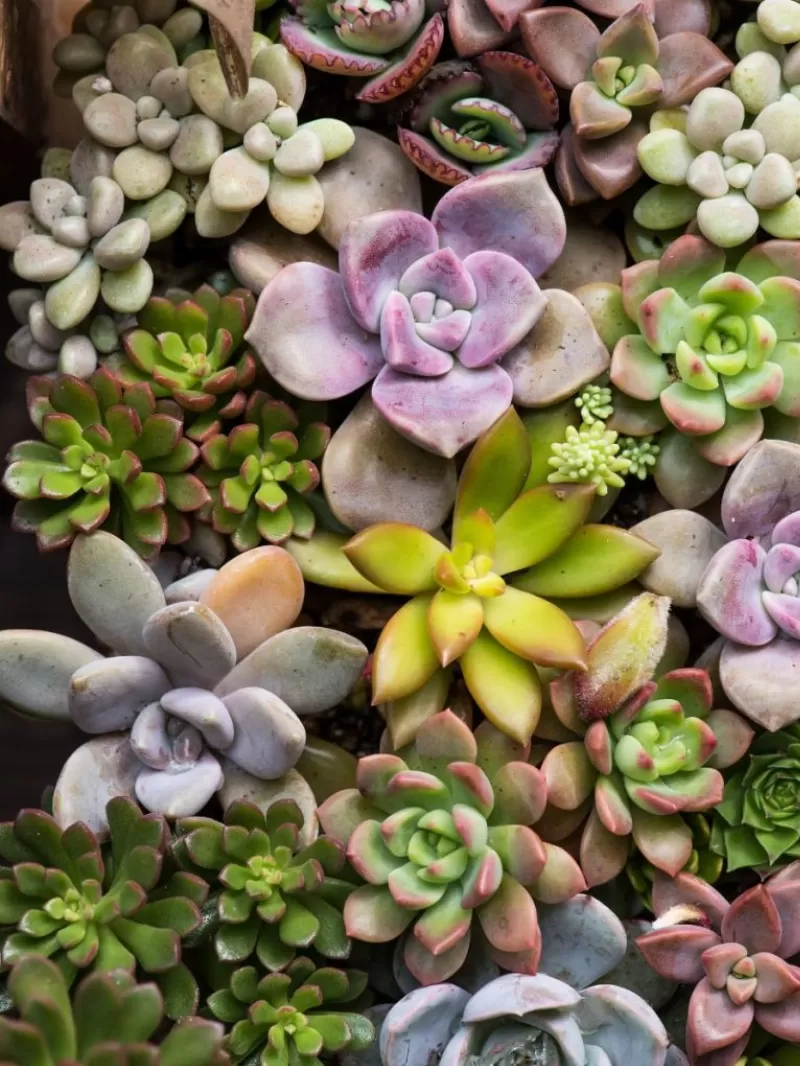- Kalanchoe Marmorata thrives in bright, indirect sunlight
- Water sparingly, allowing soil to dry between waterings
- Use well-draining soil and fertilize lightly during growing season
- Ideal for beginners due to low maintenance and pest resistance
- Toxic to pets and humans, so handle with care
As a plant enthusiast, I’ve always been drawn to unique succulents that add a touch of intrigue to any space. Among these botanical wonders, the Kalanchoe Marmorata, also known as the Penwiper Plant, stands out as a true marble masterpiece of nature. With its captivating marbled leaves and occasional delicate blooms, this low-maintenance beauty has become a favorite in my collection. Let me share my journey of caring for this remarkable plant and help you bring its enchanting presence into your home.
- How to Care for Hydrangeas Outdoors & Where to Plant Hydrangeas in the Ground
- Why Are My Jasmine Leaves Curling? 5 Potential Answers to Consider
- The Domino Cactus Pups: Easy Guide to Care and Maintenance
- Avocado Growth Stages: 6 Phases of Life
- 12 Lily of the Valley Companion Plants & Ultimate Care Guide
Understanding Kalanchoe Marmorata
Kalanchoe Marmorata is a succulent native to Madagascar, known for its striking appearance and resilient nature. As a member of the Crassulaceae family, it shares many characteristics with its succulent cousins, including drought tolerance and a preference for bright light.
You're reading: Kalanchoe Marmorata Care: Nurturing Nature’s Marble Masterpiece
Climate and Temperature Preferences
My Kalanchoe Marmorata has proven to be quite adaptable, thriving in USDA hardiness zones 9 to 11. In my experience, it’s happiest when kept in temperatures around 75°F (24°C), but don’t worry if your home gets a bit cooler – it can tolerate temperatures down to 50°F (10°C). Just remember to protect it from frost if you’re in a colder region.
Watering Wisdom
 Watering: Water once or twice per month during spring. Reduce or cut entirely when temps get below 60 or above 85 °F
Watering: Water once or twice per month during spring. Reduce or cut entirely when temps get below 60 or above 85 °F
One of the most crucial aspects of Kalanchoe Marmorata care is proper watering. I’ve learned that these plants prefer to be watered at the base to avoid leaf rot. Here’s my watering routine:
- Spring to Summer: Allow the soil to dry completely between waterings, usually every 2-3 weeks.
- Fall to Winter: Reduce watering frequency, especially when temperatures drop below 60°F or rise above 85°F.
Pro tip: If you accidentally splash water on the leaves, gently wipe it off with a tissue to prevent potential rot.
Lighting the Way to Growth
Kalanchoe Marmorata loves basking in bright, indirect sunlight. In my home, I’ve found that placing it near eastern or southern windows provides the perfect balance of light. Aim for about 6 hours of daily sunlight, but don’t worry if it gets a bit less – 3-6 hours of partial sun can still keep your plant happy.
Feeding Your Marble Beauty
 Fertilizer: apply liquid succulent/cacti plant food every 4-6 weeks in growing season (spring/summer). Avoid fertilizing during dormancy
Fertilizer: apply liquid succulent/cacti plant food every 4-6 weeks in growing season (spring/summer). Avoid fertilizing during dormancy
Read more : How to Transplant Cactus: A Beginner’s Guide to Safe Relocation
Kalanchoe Marmorata isn’t a heavy feeder, which is great news for forgetful gardeners like myself. I fertilize mine sparingly, following this schedule:
- Growing Season (Spring/Summer): Apply a liquid succulent/cacti plant food every 4-6 weeks.
- Dormant Period: Hold off on fertilizing to avoid stressing the plant.
Creating the Perfect Home for Your Kalanchoe
Soil Matters
 Soil: Requires well-ventilated, loose soil with good drainage (pH 6-6.5)
Soil: Requires well-ventilated, loose soil with good drainage (pH 6-6.5)
The right soil can make all the difference in your Kalanchoe Marmorata’s health. I’ve had great success with a well-draining mix that allows for good airflow. Here’s what I use:
- Store-bought cactus or succulent potting mix, or
- A DIY blend of organic compost, perlite, pumice, and a sprinkle of worm castings for extra nutrients
Aim for a soil pH between 6 and 6.5 to keep your plant happy.
Repotting for Growth
When it comes to repotting, less is more with Kalanchoe Marmorata. I only repot mine when it has clearly outgrown its current home. Here are some tips I’ve gathered:
- Best Time: Early to mid-spring, when the soil is warm and moist.
- Container: Choose a shallow pot with drainage holes – clay works great for moisture control.
- Weather: Pick a pleasant, cloudy day for repotting to minimize stress on the plant.
Troubleshooting Common Issues
Pests and Diseases
 Kalanchoe Marmorata are pests resistant, but can still suffer damage from aphids
Kalanchoe Marmorata are pests resistant, but can still suffer damage from aphids
One of the reasons I adore my Kalanchoe Marmorata is its resilience against pests and diseases. However, no plant is completely immune. Keep an eye out for:
- Aphids and spider mites, especially if your plant is outdoors.
- Treat any infestations promptly with organic or non-chemical insecticides.
Propagation: Spreading the Beauty
Propagating Kalanchoe Marmorata is a rewarding experience. Here’s my simple method:
- Sterilize your cutting tools.
- Cut a healthy leaf from the stem.
- Allow the cut end to dry and callous for a few days.
- Plant the leaf upright in porous soil.
- Water lightly and provide adequate sunlight.
With a little patience, you’ll soon have new plants to share with friends or expand your collection!
The Aesthetic Appeal of Kalanchoe Marmorata
Read more : The Captivating ‘White Ghost Cactus’: A Comprehensive Ghost Cactus Care Guide
 Kalanchoe Marmorata can produce flowers, which appear in white color with four delicate petals
Kalanchoe Marmorata can produce flowers, which appear in white color with four delicate petals
What truly sets Kalanchoe Marmorata apart is its stunning appearance:
- Stems: Straight, fleshy, and reddish-brown, growing in a unique decumbent pattern.
- Leaves: Initially vibrant green, maturing to a mesmerizing blueish-green or yellowish-green with captivating purple spots.
- Flowers: Occasionally, tall white blooms with four delicate petals appear, transitioning from cream-yellow to pure white.
A Word of Caution
While Kalanchoe Marmorata is a visual delight, it’s important to note that it’s toxic to both animals and humans. Keep it out of reach of curious pets and children to ensure everyone’s safety.
Embracing the Succulent Lifestyle
 But for me, succulents are a whole aesthetic world to behold!
But for me, succulents are a whole aesthetic world to behold!
Caring for Kalanchoe Marmorata has opened my eyes to the fascinating world of succulents. These resilient plants have taught me patience, mindfulness, and appreciation for nature’s subtle beauty. As I tend to my Kalanchoe, I’m reminded of the simple joys that come from nurturing a living thing.
Let me leave you with a snippet from a poem I wrote about my succulent garden:
“In arid soil, where wildflowers gleam,
My Texan succulent haven, a desert dream.”
Embracing the succulent lifestyle has brought a sense of tranquility and wonder to my home. I encourage you to explore the world of Kalanchoe Marmorata and other succulents – you might just discover a new passion!
Do you have any experiences with Kalanchoe Marmorata or other unique succulents? Share your stories in the comments below, and let’s continue to grow our knowledge together!
Source: https://thelittle.garden
Category: Cacti & Succulents
